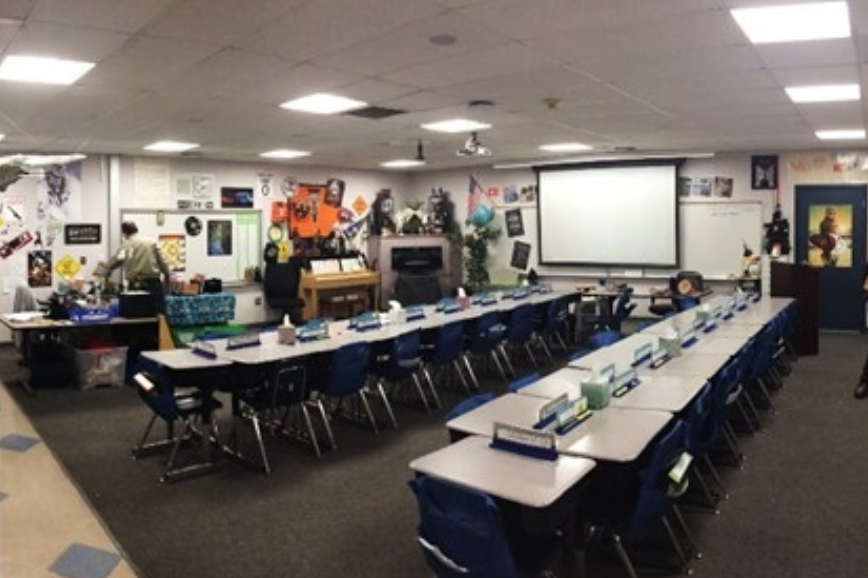The final results are in for a DOE GATEWAY evaluation of a trial installation of tunable-white LED lighting systems in three classrooms at an elementary school in Folsom, California. Pacific Northwest National Laboratory evaluated the energy and photometric performance of the adaptive systems to explore energy-saving potential. The evaluation found that if both systems are operated at full output, the LED system would provide 46% annual energy savings over the incumbent fluorescent system, while producing similar illuminances.
The trial installation of the LED lighting system was completed by Folsom Cordova Unified School District with the help of the Sacramento Municipal Utility District to understand both energy-savings potential and the potential to improve student health and academic performance, especially in children with autism spectrum disorder (ASD). The goal was to gain firsthand experience with tunable LED lighting systems, in case future evidence confirms potential positive effects on student achievement.
Tunable lighting systems offer the potential for significant energy savings relative to fluorescent systems and non-dimmable LED lighting systems. These savings are attributed to the higher efficacy of LED systems versus comparable fluorescent systems, and the dimming capability provided by tunable lighting – with additional energy savings possible in schools where illuminances exceed Illuminating Engineering Society recommendations.
BACK TO SCHOOL
The tunable LED lighting system was installed in August 2017, just before the start of the Folsom School District’s school year. One of the three classrooms was used for general-education fifth-graders and the other two for ASD students. In each classroom, existing two-lamp T8 fluorescent recessed luminaires were replaced with recessed 2′ x 2′ white-tunable LED luminaires, and one 12′ white-tunable LED wall wash surface-mounted luminaire was installed above the whiteboard. Finelite supplied the tunable LED classroom lighting system and controls, which had been developed with research and development support from a competitive funding opportunity from the Building Technologies Office’s Solid State Lighting Program.
A wall-mounted, touch-sensitive controller, which communicated with the luminaires via a DMX512 protocol, was installed next to the whiteboard and offered five preset scenes that could be altered with dimming (0%-100%) and color-tuning (2700 K to 6500K) slider bars, in addition to featuring on/off power buttons for the entire system and for the general and whiteboard luminaires separately.
ENERGY SAVINGS
Collection of energy data began during the last week of the 2016-2017 school year, while all three classrooms were operating under fluorescent lighting systems, and continued through the 2017-2018 school year. Based on the monitored energy use, the actual savings during a typical day ranged from 48% to 69%, depending on how the teacher used the controls. However, the actual energy savings throughout an entire school year will be less than that, because the DMX-controlled driver in each LED luminaire has a small power draw when the system is turned off, without which there might be tradeoffs in control flexibility, number of controllers, or dimming depth.
ADDITIONAL BENEFITS
The lighting system manufacturer provided extra hardware and software to log the teachers’ usage of the control touchpads. The resulting data revealed that each of the teachers interacted with the LED lighting system differently, and distinct patterns emerged with respect to how the controllers’ preset, intensity, and spectral power distribution buttons were used. For example, those in the ASD classrooms utilized the preset buttons and customizable slider bars regularly, while the general-education teacher mainly used the default on/off functionality; and they weren’t comfortable with a combination of higher CCT and higher illuminance settings, using the color slider or making another preset selection whenever they pressed the “Energize” button (control settings of 5000 K and more than 500 lx illuminance). The teachers viewed the preset lighting options as particularly beneficial because they were quick to implement, and noted that the presets were a way to get students’ attention or cue them to transition between certain activities. According to the teachers, the lights were more effective in getting students’ attention than any other method they had tried. They considered the lighting system’s dimmability to be particularly valuable, with color-tunability seen as a secondary benefit. The individual differences between teachers in their use of controls showed the opportunity that tunable LED lighting systems can provide for customizing the educational setting.
The trial LED lighting installation at FCUSD not only offered significant energy savings compared to the incumbent fluorescent system but ultimately provided teachers with an additional tool for facilitating classroom activities. The implementation of the lighting system varied between classrooms, but the teachers included in this study agreed that the LED lighting system offered an improved working environment for themselves and the students.
